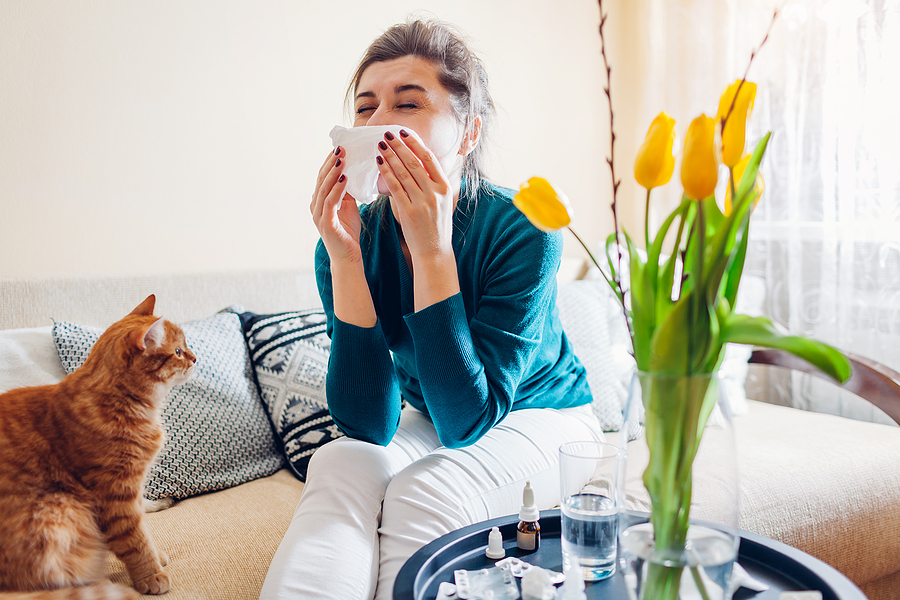In Allergies and Sensitivities: A Rising Health Concern, I talked about how common allergies are these days, and how important it is to recognize that in addition to acute allergies to specific stimuli, chronic allergies and sensitivities can also be a major problem for women.
We are surrounded by potential irritants that will bother some people immensely while others have no issue at all. The truth is, every substance on earth that can be eaten, inhaled, or touched is a potential allergen. Whether or not it negatively affects you depends on your individual genetic profile and how well your system is running.
Much is made of the genetic factors in allergies, but often your emotional inheritance, lifestyle, diet, and physical environment are more important, in part because they define the “body burden” your system must detoxify and process on a daily basis.
How allergic you are at any one time relates to how well you process this “toxic load.” One reason we often see women come in with adult-onset food allergies is that the older we get, the greater this burden becomes on our bodies, and the less they are able to deal with it.
It can be tough for women to understand the build-up that occurs in their bodies as a result of exposure to hidden sensitivities to common allergens.
When Betty came to see me and I told her I thought she should try eliminating gluten from her diet she scoffed. “I’ve been eating bread and wheat products my whole life. Don’t you think I would have realized by now if it bothered me?” she asked. But when I explained the effect that chronic exposure to something can have, she agreed to give it a try.
In this article, I’ll talk about the allergen exposure we all face daily, some of the most common allergens that impact women, and then I’ll offer some natural lifestyle solutions that can help you find relief.
Allergen exposure
Even if you eat well and live a healthy lifestyle, you may be inadvertently exposed to numerous chemicals and potential allergens. There are over 3000 chemicals added to our food supply, and more than 70,000 chemicals used for other purposes in North America.
That fresh scent you get from fabric softener or Febreze is all-chemical — when you sniff it, those particles go up your nose and into your lungs. There are dozens of heavy metals, lead among them, and chlorine in our water. Phthalates and VOC’s (volatile organic compounds) are dangerous substances used abundantly in construction and household products, fragrances, and plastics.
Over the course of many years, all this chemical exposure has a cumulative effect. If you add the other factors so prevalent in the modern woman’s life — poor diet, emotional stress, and hormonal imbalance — it’s a marvel our bodies can cope at all. No wonder the majority of my patients come in with chronic low-grade inflammation!
Common allergen categories
Because everyone is different, the range of potential allergens is huge. More than 11 million Americans have a diagnosed food allergy, but countless more have food sensitivities — often to a certain amino acid or food additive.
For brevity’s sake, I’ve included the most common categories of allergens and the top contenders in each category below. But If none of these apply, and you have symptoms consistent with allergies, I encourage you to dig a little deeper.
- Food and ingestants: Dairy, wheat (and other gluten-containing grains), corn, soy, shellfish, eggs, nightshades, nuts, chocolate, caffeine, yeast, medications, sulfites, salicylates, MSG and other glutamates, xanthan and other gums, artificial food coloring and preservatives (BHA and BHT), sorbic and benzoic acid, pesticides.
- Inhalants: Mold, pollen, dust, dust mites, animal hair and dander, synthetic fiber off-gases, down, feathers, artificial chemicals, VOC’s, scented candles and cleaning products, perfumes.
- Contact substances: Latex; plastics; cleaning solvents; insect bites; and chemicals in air, water, cosmetics, sunscreens, shampoos, and other personal care products.
Examining what you ingest
The easiest category to address is what you put into your body. That’s because, in this category at least, the choice is solely up to you.
Everything you eat can be supportive or burdensome, depending on your unique profile. Many of my patients have seen marked improvement when they pay closer attention to their nutrition — even those with type I allergies. The idea is to better equip your body to process its toxic load by providing it with the right nutrients, and to minimize the toxic load by eliminating dietary allergens. That way, when a particularly sensitive substance gets introduced to your system, your body is well equipped to handle it without causing allergic symptoms.
While the list of known allergens is long, there are two that I have seen cause the most problems for women I see: sugar and wheat. Let’s take a closer look at these now.
Sugar: the secret saboteur
Sugar is not recognized by traditional doctors as an allergen — after all, goes the party line, our body breaks down all of our food into glucose, or blood sugar — so how can anyone be allergic to sugar?
Although sugar may not register on a standard allergy test, too much sugar (or carbohydrates with a high glycemic value) does invoke an inflammatory response similar to what the immune system mounts to an allergen. How?
Well, too much sugar (or even worse, high-fructose corn syrup) places major demands on our digestive system, interfering with absorption of crucial vitamins and minerals. Too much sugar suppresses the immune system, wreaks havoc on the metabolism, and depletes valuable neurotransmitters.
The energy rush and insulin spike that you get from sugar creates an imbalanced body chemistry that leads to weight gain, insulin resistance, and loss of appetite control. Confusion, forgetfulness, hyperactivity and depression are symptoms that can occur as much as 48 hours after eating excess sugar. Muscle cramping, PMS, joint pain, and fatigue are more common symptoms of a sugar sensitivity that can go undiagnosed for years.
I would say that the bulk of the patients I see have issues that relate to excessive sugar consumption — it’s hard to avoid sugar in our culture.
Those who try to avoid it often do so by consuming products sweetened with artificial substances like Splenda, which only adds to your toxic burden. Removing sugar from your diet — without replacing it with chemical sweeteners — can be a very powerful natural remedy for women with allergies and hidden sensitivities.
Wheat, gluten sensitivities, and allergies
It’s estimated that over 90 million Americans have certain genetic variants that make them sensitive to gluten.
Remember, hunting and gathering were around for two million years before the dawn of agriculture. And people who descend from cultures dependent on corn, potatoes, rice or other grains often do not possess the genetic snippet (SNP) required to process grains in the wheat tribe.
Many of us don’t know we are gluten-sensitive because gluten can cause symptoms that don’t involve the gastrointestinal (GI) tract, like infertility and decreased cognitive function.
Gluten is actually an umbrella term for a family of proteins found within the seeds or grains of wheat, rye, barley, spelt, kamut, and triticale. Gluten sensitivity differs from celiac disease (a genetically inherited condition in which the lining of the small intestine suffers damage if gluten is eaten), but together they make up a large percentage of people who don’t do well with cereal products.
In such cases, the immune system responds to gluten as if it was an intruder in the body, not a food.
If you are gluten-sensitive and continue to eat the recommended daily allowance of cereals and grains in the form of wheat and wheat relatives, your body will simmer on a low burn. This will eventually wear down the immune system and disrupt your metabolism, setting the stage for systemic inflammation, weight gain, chronic disease and a snowball effect of other sensitivities.
The irony in this is that our notion of “comfort food” often means a combination of wheat and sugar! Think about what donuts, sticky buns, and cake are made of. But why do we crave the very foods that make us sick?
The allergy–addiction connection
It’s not uncommon for people to feel better for a short time after they eat the foods to which they are sensitive or allergic. It’s possible that their bodies have grown used to this dysfunctional body chemistry and suffer withdrawal symptoms when deprived. Nature likes homeostasis.
Poor digestion can lead to build-up of a kind of digestive sludge (called ama in Ayurvedic medicine) that interferes with all of your body’s functions. The mental fog and sluggishness that result have an anesthetizing effect: it literally wipes you out and distracts you from your present (now you know what’s behind comfort food).
This kind of “food coma” can itself be addictive, like alcohol. And if the sludge isn’t eventually cleared, most people reach a tipping point and have to deal with allergic symptoms.
Emotional connections
Although there’s no medical research to back up this theory, I think it’s important to mention the emotional connection to food addiction and sensitivities. I’ve seen it time and again in my patients, often enough to believe it has merit.
Consider this example. Perhaps as a child you were prone to spilling your milk. Each time it happened you were yelled at or spanked and your body reacted in kind. Guess what happens when you get older? A glass of milk may put your system in revolt.
In contrast, perhaps the only time you ever felt cared for by your mother was when she set down cookies and milk for you after school. Your feelings of safety and comfort are deeply embedded in that ritual.
We know that emotional pathways can be hard-wired, like grooves in a record, so that these rituals express an unresolved experience — if we can just understand their origin. But that doesn’t mean they’re good for you. Please see our article on emotions and health for more on this topic.
My approach to finding natural relief from common allergens
Understanding that hidden sensitivities and allergens may be a factor in your uncomfortable symptoms is the first step. But how do you uncover what, exactly, is happening in your body?
My first step is to discuss all of the factors in your life that contribute to your “toxic load” and your ability to process it:
- Diet
- Emotional history
- Lifestyle habits
- Physical environment
- Digestion
This comprehensive approach helps me see not beyond the tip of the iceberg to what’s hidden beneath the waterline as well.
I may begin with allergy testing. There is a conventional scratch test for IgE antibody response. The radioallergosorbent test, or RAST, is a blood panel that measures IgE directly.
While these tests are good at detecting acute allergies involving IgE antibodies, they are not when it comes to allergens that trigger IgG, IgM, IgA or IgC antibodies such as food sensitivities and other non-acute allergic reactions. Certain enzyme-linked immunosorbent assays, or ELISA tests, are better at detecting these sensitivities, as they measure both IgE and IgG antibodies.
I sometimes use a family of blood tests known as ALCAT, which directly measure the allergic response of white blood cells to various panels of allergens. I’ve found ALCAT tests to be excellent indicators of the broad range of antibodies involved in sensitivities that produce delayed allergic responses.
While I pay close attention to the ALCAT test results, I’m just as interested in how a patient feels. To really get at the root problem, you have to look at the entire health picture, not just one aspect. Food issues can be a major factor in that picture, but we may need to treat the adrenals or hormonal imbalance as well.
Every woman is different, and I customize my approach to her individual needs.
That said, I can say with confidence that almost everyone feels much better when they take steps to decrease their overall body burden — even if they have severe allergies. When my son was younger, we moved into a new house.
Within days, he was wheezing and had ulcerations on his eyes. His pediatrician, a practitioner of functional medicine, told me he had asthma. We took up all the carpeting in our new house and replaced it with wood floors.
Guess what? His symptoms went away. Now, if he’s careful with his diet and avoids chemical off-gassing, he rarely has an asthma attack or needs to use an inhaler.
Natural Relief from Common Allergens
After testing to determine specific sensitivities and gathering all the necessary information from my clients about the way they live I’m ready to make some recommendations. And the good news is there are several steps you can take to find relief.
Prescriptions aren’t the only answer! And neither, by the way, is pulling up your carpets (though in some cases that may be necessary). Often, all it takes is a little more attention to the choices you make every day.
Diet
The first step toward allergy relief is easy — just look at your diet. For a week, keep track of what you eat and how you feel after eating it.
Many of my patients dread being put on a low-allergen diet. If you do too, try this easy elimination diet: Avoid a particular food entirely for two weeks, then eat a lot of it in one day and look for a reaction. At first many women feel worse when they go off a certain food (especially if they’re allergic or addicted), but if you stick with it for a few days you may be surprised how good you feel.
If you are unsure what to cut out, try eating only vegetables and fruit for a few days and gauge how you feel, then reintroduce dairy, wheat, sugar, and other food types one at a time. Many Eastern cultures practice fasting or eating lightly for a few days each month to ward off potential food sensitivities. Alternatively, you may want to try a more progressive, thorough approach with a two-week Quick Cleanse.
Sensitivities can indicate an underlying digestive issue or imbalance. When people are sensitive to certain foods, it’s usually because their GI tracts can’t fully digest the proteins in their food. The undigested proteins pass into the bloodstream and trigger an immune reaction — otherwise known as “leaky gut” syndrome.
Supplementation
A little additional support can go a long way towards warding off inflammation.
A rich multivitamin/mineral complex with adequate essential fatty acids is the cornerstone of our treatment for food sensitivities — this is often enough to correct imbalances and soothe diet-related inflammation. In some cases targeted therapeutic use of supplements is required, as determined on a case-by-case basis.
Digestive enzymes and probiotics can alleviate intestinal inflammation and help restore intestinal function. Overuse of antibiotics, hypersensitivities, and other imbalances will undermine a healthy digestive tract.
Replacing valuable enzymes and beneficial bacteria improves the body’s ability to fully break down and down absorb your food. Recent science also supports the value of probiotic supplements that contain “prebiotics” — in effect, food for our good bacteria — for reducing the allergic response.
For more information, see our article on probiotics.
Additionally, a gentle detox program can rejuvenate your GI system and soothe inflammation. If you don’t see results, you may need more guidance on how to cleanse your system of inflammatory molecules and restore optimal detox function.
Please refer to my articles about detoxification for specific suggestions.
Environmental sensitivities
Another effective way to decrease your overall body load is to clean house (literally and figuratively). Invest in a good vacuum cleaner with a HEPA filter and use it frequently. Change sheets and pillowcases often to avoid a build up of dust mites.
Go through your cabinets and throw out cleansers, creams, soaps, and cosmetics that contain irritating synthetic chemicals. Buy green building materials, furnishings, cleaners, and laundry detergents. Encase your bedding and choose all-natural fabrics and bed linens.
Some natural products, like soy and aloe, can be allergenic — and don’t overlook houseplants. When you are conscious about what you introduce into your environment, you can significantly reduce your toxic load.
Chemical sensitivities
Have you ever walked into a store and had to walk right back out because of the smell? I have!
If you find yourself becoming more and more sensitive to noxious fumes, air fresheners, perfumes, chemical odors, and other synthetic off-gassing, it’s usually a good sign that your system is on overload.
Headaches, dry mouth, sore throat, dizziness, nausea, coughing, and rashes are common symptoms of chemical sensitivity. NAET (Nambudripad’s Allergy Elimination Techniques) are an effective, noninvasive way to eliminate many sensitivities and allergies.
Using a combination of therapies, including nutrition, acupuncture/acupressure, allopathy, chiropractic care, and kinesiology, practitioners have successfully desensitized patients so that they can tolerate the offending substances without symptoms.
Emotional burdens
These are often the trickiest to clear. Talk therapy and energy work may help you connect an allergic response with any emotional underpinnings it may have. At the very least, you can determine the areas in your life that add the most emotional stress and limit them, just as you would an offending food.
The important thing to remember is that our bodies don’t function in a vacuum. If there’s a symptom, there is usually some sort of emotional root — and vice versa. Please take the time to read my important article, “How Emotional Experience Determines Your Health.”
Ease your body burden to feel better!
Remember Betty? After we talked through all the factors that could be impacting her body’s reaction to common allergens, she was ready to try my advice.
She went through her house tossing things that could be contributing to her toxic load, started taking a quality multivitamin, and made some time for herself to de-stress. But the biggest difference came from leaving gluten off her menu for two weeks.
Her symptoms had greatly subsided while she avoided gluten. When she tested the theory by eating a sandwich, her body quickly let her know what I’d suspected all along: gluten was not a friend to her system!
Discovering hidden sensitivities doesn’t necessarily mean you can never eat a sandwich again (though Betty said she wasn’t sure she’d ever want to). But having the best possible information about what is impacting your body allows you to make conscious choices about what you expose yourself to.
When you find the right balance for your system, you can live the healthy, vibrant life you want – and deserve!








